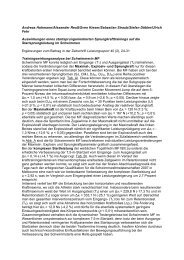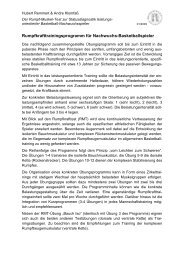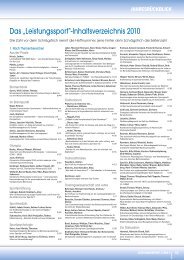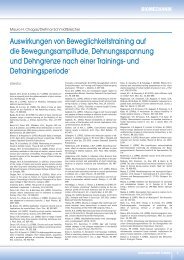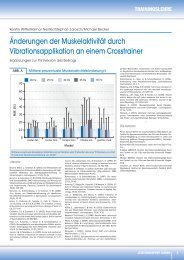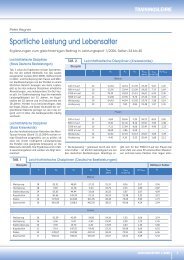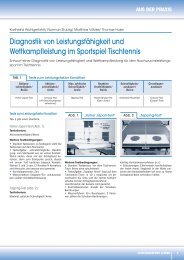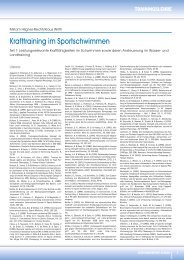Ergänzungen und/oder Literaturliste - Leistungssport
Ergänzungen und/oder Literaturliste - Leistungssport
Ergänzungen und/oder Literaturliste - Leistungssport
Create successful ePaper yourself
Turn your PDF publications into a flip-book with our unique Google optimized e-Paper software.
Hagen Hartmann/Andreas Bob/Klaus Wirth/Dietmar Schmidtbleicher<br />
Literatur<br />
Aagaard, P., Simonsen, E.B., Andersen, J.L., Magnusson, P. &<br />
Dyhre-Poulsen, P. (2002). Increased rate of force development<br />
and neural drive of human skeletal muscle following<br />
resistance training. Journal of Applied Physiology, 93, 1318-<br />
1326.<br />
Ahtiainen, J. P., Pakarinen, A., Alen, M., Kraemer, W.J. & Häkkinen,<br />
K. (2005). Short vs. long rest period between the sets<br />
in hypertrophic resistance training: influence on muscle<br />
strength, size, and hormonal adaptations in trained men.<br />
Journal of Strength and Conditioning Research, 19 (3), 572-<br />
582.<br />
Ahtiainen, J. P., Pakarinen, A., Kraemer, W.J. & Häkkinen, K.<br />
(2003). Acute hormonal and neuromuscular responses and<br />
recovery to forced vs. maximum repetitions multiple resis -<br />
tance exercises. International Journal of Sports Medicine,<br />
24, 410-418.<br />
Allen, D.G., Lännergren, J. & Westerblad, H. (1995). Muscle<br />
cell function during prolonged activity: cellular mecha nisms<br />
of fatigue. Experimental Physiology, 80, 497-527.<br />
Baker, D., Wilson, G. & Carlyon, R. (1994). Periodization: The<br />
effect on strength of manipulating volume and intensity. Journal<br />
of Strength and Conditioning Research, 8 (4), 235-242.<br />
Bayer, G. (1999). Untersuchungen zur Bewegungsgeschwindigkeit<br />
als Belastungskennziffer im Krafttraining sowie zur<br />
Schnellkraft- <strong>und</strong> Schnellkraftausdauerfähigkeit als Faktoren<br />
der Struktur personeller Leistungsvoraussetzungen in Ausdauersportarten<br />
am Beispiel von Rudersportlern. Habilita -<br />
tionsschrift, Berlin.<br />
Bernardi, M., Felici, F., Marchetti, M., Montellanico, F, Piacentini,<br />
M.F. & Solomonow, M. (1998). Motor unit recruitment<br />
strategy changes with strength improvement. In A.J. Sargeant<br />
& H. Siddons (Hrsg.): From Community Health to Elite<br />
Sport - Proceedings of Third Annual Congress of the European<br />
College of Sport Science (S. 220). Manchester 1998.<br />
Brandenburg, J. P. & Docherty, D. (2002). The effects of accentuated<br />
eccentric loading on strength, muscle hypertrophy,<br />
and neural adaptations in trained individuals. Journal of<br />
Strength and Conditioning Research, 16 (1), 25-32.<br />
Bührle, M. (1985). Dimensionen des Kraftverhaltens <strong>und</strong> ihre<br />
spezifischen Trainingsmethoden. In M. Bührle. (Hrsg.),<br />
Gr<strong>und</strong>lagen des Maximal- <strong>und</strong> Schnellkrafttrainings (S. 83-<br />
111). Schorndorf: Hofmann.<br />
Bührle, M., Gollhofer, A., Kibele, A., Müller, K.-J., Schwirtz, A.,<br />
Schweizer, L. & Strass, D. (1995). Theorie <strong>und</strong> Praxis des<br />
Krafttrainings. In K. Carl, K. Quade & P. Stehle (Hrsg.), Krafttraining<br />
in der sportwissenschaftlichen Forschung (S. 177-<br />
215). Köln: Sport <strong>und</strong> Buch Strauß.<br />
Bührle, M. & Schmidtbleicher, D. (1977). Der Einfluß von Maximalkrafttraining<br />
auf die Bewegungsschnelligkeit. Leis -<br />
tungssport, 7 (1), 3-10.<br />
Bührle, M. & Schmidtbleicher, D. (1981). Maximalkraft –<br />
Schnellkraft – Bewegungsschnelligkeit. In D. Augustin & N.<br />
Müller (Hrsg.), Leichtathletiktraining im Spannungsfeld von<br />
Wissenschaft <strong>und</strong> Praxis (S. 256-272). Niedernhausen/Ts:<br />
Schors.<br />
Campos, G.E.R., Luecke, T.J., Wendeln, H.K., Toma, K., Hagerman,<br />
F.C., Murray, T.F., Ragg, K.E., Ratamess, N.A., Kraemer,<br />
W.J. & Staron, R.S. (2002). Muscular adaptations in response<br />
to three different resistance-training regimens: specificity of<br />
repetition maximum training zones. European Journal of Applied<br />
Physiology, 88, 50-60.<br />
Cheng, A.J. & Rice, Ch.L. (2005). Fatigue and recovery of<br />
power and isometric torque following isotonic knee extensions.<br />
Journal of Applied Physiology, 99, 1446-1452.<br />
Chilibeck, P.D., Calder, A.W., Sale, G. & Webber, C.E. (1998). A<br />
comparison of strength and muscle mass increases during<br />
resistance training in young women. European Journal of<br />
Applied Physiology 77, 170-175.<br />
Crill, M., Campos, G., Staron, R.S., Hagerman, F.C., Luecke, T.,<br />
Bailey, T., Kraemer, W.J. & Hikida, R.S. (1998). Different resis -<br />
tance training protocols and skeletal muscle fiber hypertrophy.<br />
Medicine and Science in Sports and Exercise, 30 (5, suppl.),<br />
S207.<br />
DeProft, E., Carbri, J., Dufour, W. & Clarys, J.P. (1988).<br />
Strength training and kick performance in soccer players. In<br />
T. Reilly, A. Lees, K. Davids & W. J. Murphy (Eds.), Science and<br />
Football: Proceedings of the First World Congress of Science<br />
and Football (pp. 108-113). London: E. & F.N. SPON.<br />
Desmedt, J.E. (1981). The size principle of motoneuron<br />
recruitment in ballistic or ramp voluntary contractions in<br />
man. In J. E. Desmedt (Ed.), Motor Unit Types, Recruitment<br />
and Plasticity in Health and Disease. Progress in Clinical<br />
Neurophysiology, vol. 9 (pp. 97-136). Basel, New York: Karger.<br />
Desmedt, J. E. & Godaux, E. (1977a). Ballistic contractions in<br />
man: characteristic recruitment pattern of single motor units<br />
of the tibialis anterior muscle. Journal of Physiology, 264 ,<br />
673-693.<br />
Desmedt, J. E. & Godaux, E. (1977b). Fast motor units are<br />
not preferentially activated in rapid voluntary contractions in<br />
man. Nature, 267, 717-719.<br />
Desmedt, J. E. & Godaux, E. (1978). Ballistic contractions in<br />
fast or slow human muscles: discharge patterns of single<br />
motor units. Journal of Physiology, 285, 185-196.<br />
Desmedt, J. E. & Godaux, E. (1979). Voluntary motor commands<br />
in human ballistic movements. Annals of Neurology,<br />
5, 415-421.<br />
Dons, B., Bollerup, K., Bonde-Petersen, F. & Hancke, S.<br />
(1979). The effect of weight-lifting exercise related to mus -<br />
cle fiber composition and muscle cross-sectional area in humans.<br />
European Journal of Physiology, 40, 95-106.<br />
Dutta, P. & Subramanium, S. (2002). Effects of six weeks of<br />
isokinetic strength training combined with skill training on<br />
football kicking performance. In W. Spinks, T. Reilly & A. Murphy<br />
(Eds.), Science and Football IV (pp. 333-340). London:<br />
Routledge.<br />
Edman, K. A. P. (2003). Contractile performance of skeletal<br />
muscle fibres. In P. V. Komi (Ed.), Strength and Power in<br />
Sport 2 (pp. 114-133). Malden (USA): Blackwell Science.<br />
Ehlenz, H., Grosser, M. & Zimmermann, E. (2003). Krafttraining.<br />
Gr<strong>und</strong>lagen, Methoden, Übungen, Leistungssteuerung,<br />
Trainingsprogramme. München: BLV Sportwissen.<br />
Felici, F., Rosponi, A., Sbriccoli, P., Filligoi, G.C., Fattorini, L. &<br />
Marchetti, M. (2001). Linear and non-linear analysis of sur -<br />
face electromyograms in weightlifters. European Journal of<br />
Applied Physiology, 84, 337-342.<br />
Fichte, R. B., Güllich, A. & Schmidtbleicher, D. (1994). Entwicklung<br />
eines Meßverfahrens zur Geschwindigkeitsdiagnose<br />
an Krafttrainingsgeräten. In D. Schmidtbleicher & A. F.<br />
Müller (Hrsg.), Leistungsdiagnostische <strong>und</strong> präventive<br />
Aspekte der Biomechanik (S. 159-165). St. Augustin: Academia.<br />
Fitts, R.H. & Balog, E.M. (1996). Effect of intracellular and extracellular<br />
ion changes on E-C coupling and skeletal muscle<br />
fatigue. Acta Physiologica Scandinavica, 156, 169-181.<br />
TRAININGSLEHRE<br />
Auswirkungen unterschiedlicher Periodisierungs -<br />
modelle im Krafttraining auf das Schnellkraft- <strong>und</strong><br />
Explosivkraftverhalten der oberen Extremität<br />
Fitts, R.H. & Widrick, J.J. (1996). Muscle mechanics: adaptations<br />
with exercise-training. Exercise and Sport Science Reviews,<br />
24, 427-473.<br />
Fleck, S.J. & Kraemer, W.J. (2004). Designing resistance<br />
train ing programs 3 . Champaign, IL: Human Kinetics.<br />
Frick, U., Wirth, K., Schlumberger, A. & Schmidtbleicher, D.<br />
(2000). Recovery following muscle hypertrophy strength<br />
training sessions with different training regimen – eccentric<br />
versus concentric muscle actions. In J. Avela, P. V. Komi & J.<br />
Komulainen, 5th Annual Congress of the European College of<br />
Sport Science (pp. 270), Jyväskylä, Finnland.<br />
Fry, A. C., Webber, J.M., Weiss, L.W., Harber, M.P., Vaczi, M. &<br />
Pattison, N.A. (2003a). Muscle fiber characteristics of competitive<br />
power lifters. Journal of Strength and Conditioning<br />
Research, 17 (2), 402-410.<br />
Fry, A. C., Schilling, B. K., Staron, R. S., Hagerman, F. C., Hikida,<br />
R. S. & Thrush, J.T. (2003b). Muscle fiber characteristics<br />
and performance correlates of male Olympic-style weight -<br />
lifters. Journal of Strength and Conditioning Research, 17<br />
(4), 746-754.<br />
Goldspink, G. & Harridge, S. (2003). Cellular and molecular<br />
aspects of adaptation in skeletal muscle. In P. V. Komi (Ed.),<br />
Strength and Power in Sport 2 (pp. 231-251). Malden (USA):<br />
Blackwell Science.<br />
Grantyn, K.Ch. (1939). In: Theorie <strong>und</strong> Praxis der Körperkultur,<br />
Moskau, 8 (7)<br />
Häkkinen, K. (1985). Factors influencing trainability of muscular<br />
strength during short term and prolonged training. National<br />
Strength and Conditioning Association Journal, 7 (2),<br />
32-37.<br />
Häkkinen, K., Alén, M. & Komi, P.V. (1985). Changes in isometric<br />
force- and relaxation-time, electromyographic and<br />
muscle fibre characteristics of human skeletal muscle during<br />
strength training and detraining. Acta Physiologica Scandinavica,<br />
125, 573-585.<br />
Häkkinen, K. & Häkkinen, A. (1991). Muscle cross-sectional<br />
area, force production and relaxation characteristics in women<br />
at different ages. European Journal of Applied Physiology,<br />
62, 410-414.<br />
Häkkinen, K., Komi, P.V. & Alén, M. (1985). Effect of explosive<br />
type strength training on isometric force- and relaxationtime,<br />
electromyographic and muscle fibre characteristics of<br />
leg extensor muscles. Acta Physiologica Scandinavica, 125,<br />
587-600.<br />
Hemmling, G. (1994). Anpassungen des neuromuskulären<br />
Systems an eine neuentwickelte Trainingsmethode. Köln:<br />
Sport <strong>und</strong> Buch Strauß.<br />
Heyden, G., Droste, J. & Steinhöfer, D. (1988). Zum Zusammenhang<br />
von Maximalkraft, Schnellkraft <strong>und</strong> Bewegungsschnelligkeit.<br />
<strong>Leistungssport</strong>, 18 (2), 39-46.<br />
Hoff, J. & Almasbakk, B. (1995). The effects of maximum<br />
strength training on throwing velocity and muscle strength<br />
in female team-handball players. Journal of Strength and<br />
Conditioning Research, 9 (4), 255-258.<br />
Ivanov, L., Krugliy, V. & Zinchenko, V. (1977). Individualized<br />
strength development for throwers. Legkaya Atletika, 11<br />
(12), 138-139.<br />
Jostarndt-Fögen, K., Billeter, R. & Hoppeler, H. (1997). Fiber<br />
type characteristics and myosin light chain expression in a<br />
world champion shot putter. Schweizerische Zeitschrift für<br />
Sportmedizin <strong>und</strong> Sporttraumatologie, 45, 160.<br />
Kanehisa, H. & Miyashita, M. (1983). Effect of isometric and<br />
isokinetic muscle training on static strength and dynamic power.<br />
European Journal of Applied Physiology, 50, 365-371.<br />
LEISTUNGSSPORT 3/2008<br />
1
2<br />
TRAININGSLEHRE<br />
Kang, J., Hoffman, J.R., Im, J., Spiering, B.A., Ratamess,<br />
N.A., R<strong>und</strong>ell, K.W., Nioka, S., Cooper, J. & Chance, B. (2005).<br />
Evaluation of physiological responses during recovery fol -<br />
lowing three resistance exercise programs. Journal of<br />
Strength and Conditioning Research, 19 (2), 305-309.<br />
Kibele, A. (1998). Maximalkraftzuwachs ohne Leistungs -<br />
gewinn? <strong>Leistungssport</strong>, 28 (3), 45-49.<br />
Kibele, A., Müller, K.-J. & Bührle, M. (1989). Bilaterale Defizite<br />
bei willkürlichen Maximalkontraktionen. Deutsche Zeitschrift<br />
für Sportmedizin, 40 (4), 120-134.<br />
Kjær, M., Kalimo, H. & Saltin, B. (2003). Skeletal muscle: physiology,<br />
training and repair after injury. In: M. Kjær, M. Krogsgaard,<br />
P. Magnusson, L. Engebretsen, H. Roos, T. Takala & S.L-<br />
YWoo (Hrsg.), Textbook of Sports Medicine (S. 49-69).<br />
Blackwell Science: Oxford.<br />
Komi, P.V. & Buskirk, E.R. (1972). Effect of eccentric and concentric<br />
muscle conditioning on tension and electrical activity<br />
of human muscle. Ergonomics, 15 (4), 417-434.<br />
Kraemer, W. J. (1997). A series of studies – The physiological<br />
basis for strength training in American Football: Fact over<br />
philosophy. Journal of Strength and Conditioning Research,<br />
11 (3), 131-142.<br />
Kraemer, W. J., Fleck, S. J. & Evans, W. J. (1996). Strength<br />
and power training: physiological mechanisms of adaptation.<br />
Exercise and Sport Sciences Reviews, 24, 363-397.<br />
Kraemer, W. J., Noble, B. J., Clark, M. J. & Culver, B. W.<br />
(1987). Physiological responses to heavy-resistance exercise<br />
with very short rest periods. International Journal of Sports<br />
Medicine, 8, 247-252.<br />
Kraemer, W. J., Ratamess, N., Fry, A. C. Triplett-McBride, T.,<br />
Koziris, L. P., Bauer, J. A., Lynch, J. M. & Fleck, S. J. (2000). Influence<br />
of resistance training volume and periodization on<br />
physiological and performance adaptations in collegiate<br />
women tennis players. The American Journal of Sports<br />
Medicine, 28 (5), 626-633.<br />
Lachowetz, T., Evon, J. & Pastiglione, J. (1998). The effects of<br />
an upper body strength program on intercollegiate baseball<br />
throwing velocity. Journal of Strength and Conditioning Research,<br />
12 (2), 116-119.<br />
Lüthi, J.-M., Gerber, C., Claassen, H. & Hoppeler, H. (1989).<br />
Die verletzte <strong>und</strong> die immobilisierte Muskelzelle: Ultrastrukturelle<br />
Betrachtungen. Sportverletzung Sportschaden, 3,<br />
58-61.<br />
MacDougall, J.D. (2003). Hypertrophy and Hyperplasia. In P.<br />
V. Komi (Hrsg.), Strength and Power in Sport 2 (pp. 252-264).<br />
Malden (USA): Blackwell Science.<br />
Maibäurl, H. & Maassen, N. (2002). Ionenhomöostase, Muskelkontraktilität<br />
<strong>und</strong> muskuläre Ermüdung. Deutsche Zeitschrift<br />
für Sportmedizin, 53 (9), 238-243.<br />
Malisoux, L, Francaux, M., Nielens, H. & Theisen, D. (2005).<br />
Stretch-shortening cycle exercises: an effective training paradigm<br />
to enhance power output of human single muscle fibers.<br />
Journal of Applied Physiology, 100, 771-779.<br />
Manolopoulos, E., Papadopoulos, C. & Kellis, E. (2006). Effects<br />
of combined strength and kick coordination training on<br />
soccer kick biomechanics in amateur players. Scandinavian<br />
Journal of Medicine and Science in Sports, 16 (2), 102-110.<br />
Marx, J., Ratamess, N. A., Nindl, B. C., Gotshalk, L. A., Volek,<br />
J. S., Dohi, K., Bush, J. A., Gomez, A. L., Mazzetti, S. A., Fleck,<br />
S. J., Häkkinen, K., Newton, R. U. & Kraemer, W. J. (2001).<br />
Low-volume circuit versus high-volume periodized resis -<br />
tance training in women. Medicine and Science in Sports and<br />
Exercise, 33 (4), 635-643.<br />
Matwejew, L.P. (1978). Periodisierung des sportlichen Trainings<br />
3 . Berlin: Bartels <strong>und</strong> Wernitz.<br />
Mayhew, J.L., Ware, J.S., Johns, R.A. & Bemben, M.G. (1997).<br />
Changes in upper body power following heavy-resis tance<br />
strength training in college-men. International Journal of<br />
Sports Medicine 18, S. 516-520<br />
Milner-Brown, H.S., Stein, R.B. & Lee, R.G. (1975). Synchronization<br />
of human motor units: possible roles of exercise and<br />
supraspinal reflexes. Electroencephalography and Clinical<br />
Neurophysiology, 38, 245-254.<br />
Moffroid, M. T. & Whipple, R.H. (1970). Specificity of speed of<br />
exercise. Physical Therapy, 50 (12), 1692-1699.<br />
Moritani, T. (2003). Motor unit and motoneurone excitability<br />
during explosive movement. In P. V. Komi (Ed.), Strength<br />
and Power in Sport 2 (pp. 27-49). Malden (USA): Blackwell<br />
Science.<br />
Moritani, T. & DeVries, H.A. (1979). Neural factors versus<br />
hypertrophy in the time course of muscle strength gains.<br />
American Journal of Physical Medicine, 58 (3), 115-130.<br />
LEISTUNGSSPORT 3/2008<br />
Moss, B. M., Refsnes, P. E., Abildgaard, A., Nicolaysen, K. &<br />
Jensen, J. (1997). Effect of maximal effort strength training<br />
with different loads on dynamic strength, cross-sectional<br />
area, load-power <strong>und</strong> load-velocity relationships. European<br />
Journal of Applied Physiology, 75, 193-199.<br />
Müller, G. (1994). Adäquate Belastungsnormativa des<br />
Schnellkrafttrainings. In R. Brack, A. Hohmann & H. Wieland<br />
(Hrsg.), Trainingssteuerung – konzeptionelle <strong>und</strong> trainingsmethodische<br />
Aspekte. Sportwissenschaft <strong>und</strong> Praxis, Band 6<br />
(S. 207-211). Stuttgart: Nagelschmid.<br />
Müller, K.-J. (1987). Statische <strong>und</strong> dynamische Muskelkraft.<br />
Freiburger Dissertationsschrift. Frankfurt am Main: Deutsch.<br />
Murphy, A. J., Wilson, G. J., Pryor, J. F. & Newton, R. U. (1995).<br />
Isometric assessment of muscular function: the effect of joint<br />
angle. Journal of Applied Biomechanics, 11, 205-215.<br />
Narici, M.V., Hoppeler, H., Kayser, B., Landoni, L., Claassen,<br />
H., Gavardi, C., Conti, M. & Cerretelli, P. (1996). Human quadriceps<br />
cross-sectional area, torque and neural activation<br />
during 6 months strength training. Acta Physiologica Scandinavica,<br />
157 (2), 175-186.<br />
Newton, R. U. & McEvoy, K.P. (1994). Baseball throwing velocity:<br />
A comparison of medicine ball training and weight training.<br />
Journal of Strength and Conditioning Research, 8 (3),<br />
198-203.<br />
O’Bryant, H. S., Byrd, R. & Stone, M. H. (1988). Cycle ergometer<br />
performance and maximum leg and hip strength adaptations<br />
to two different methods of weight-training. Journal<br />
of Applied Sport Science Research, 2 (27), 27-30.<br />
Pampus, B. (2001). Schnellkrafttraining. Theorie – Methoden<br />
– Praxis 2 . Aachen: Meyer & Meyer.<br />
Peiper, U. (2000). Muskulatur. In R. Klinke & S. Silbernagl<br />
(Hrsg.), Lehrbuch der Physiologie 3 (S. 81-107). Stuttgart:<br />
Georg Thieme.<br />
Piacentini, M.F., Bernardi, M., Felici, F, Marino, S., Montellanico,<br />
F. & Solomonow, M. (1998). Motoneuron adaptations to<br />
strength training. Medicine and Science in Sports and Exercise,<br />
30, S. 227.<br />
Platonov, V. N. (1999). Belastung – Ermüdung – Leistung: Der<br />
m<strong>oder</strong>ne Trainingsaufbau. Band 34 der DSB-Trainerbibliothek.<br />
Münster: Philippka.<br />
Plisk, S. S. & Stone, M. H. (2003). Periodization strategies.<br />
Strength and Conditioning Journal, 25 (6), 19-37.<br />
Poliquin, C. (1988). Five steps to increasing the effectiveness<br />
of your strength training program. National Strength and<br />
Conditioning Association Journal, 10 (3), 34-39.<br />
Pryor, J.F., Wilson, G.J. & Murphy, A.J. (1994). The effective -<br />
ness of eccentric, concentric and isometric rate of force development<br />
tests. Journal of Human Movement Studies, 27,<br />
153-172.<br />
Rhea, M. R., Ball, S. D. , Phillips, W. T. & Burkett, L. N. (2002).<br />
A comparison of linear and daily <strong>und</strong>ulating periodized programs<br />
with equated volume and intensity for strength. Journal<br />
of Strength and Conditioning Research, 16 (2), 250-255.<br />
Robergs, R.A. & Amann, M. (2003). Belastungsbedingte metabolische<br />
Azidose: Woher kommen die Protonen? Österreichisches<br />
Journal für Sportmedizin, 3, 11-25<br />
Robergs, R.A., Pearson, D.R., Costill, D.L., Fink, W.J., Pascoe,<br />
D.D., Benedict, M.A., Lambert, C.P. & Zachweija, J.J. (1991).<br />
Muscle glycogenolysis during differing intensities of weightresistance<br />
exercise. Journal of Applied Physiology, 70 (4),<br />
1700-1706.<br />
Rutherford, O. M. & Jones, D. A. (1986). The role of learning<br />
and coordination in strength training. European Journal of<br />
Applied Physiology, 55, 100-105.<br />
Sahlin, K. (2006). Metabolic factors in fatigue. In M. Hargreaves<br />
& L. Spriet (Eds.), Exercise metabolism 2 (pp. 163-<br />
186). Champaign, IL: Human Kinetics.<br />
Sale, D.G. (2003). Neural adaptation to strength training. In<br />
P. V. Komi (Ed.), Strength and Power in Sport 2 (pp. 281-314).<br />
Malden (USA): Blackwell Science.<br />
Schlumberger, A. (2000). Optimierung von Trainingsstrate -<br />
gien im Schnellkrafttraining. B<strong>und</strong>esinstitut für Sportwissenschaft.<br />
Köln: Sport <strong>und</strong> Buch Strauß.<br />
Schlumberger, A., Scheuer, S. & Schmidtbleicher D. (1999).<br />
Effects of strength training with superimposed vibrations.<br />
Proceedings of the 4th annual Congress of the European College<br />
of Sport Science (p. 416). Rom.<br />
Schlumberger, A. & Schmidtbleicher, D. (1998). Zeitlich verzögerte<br />
Effekte beim Krafttraining. <strong>Leistungssport</strong>, 28 (3),<br />
33-38.<br />
Schmidtbleicher, D. (1980). Maximalkraft <strong>und</strong> Bewegungsschnelligkeit.<br />
Bad Homburg: Limpert.<br />
Schmidtbleicher, D (1994). Training for Power Events. In P. V.<br />
Komi (Ed.), Strength and Power in Sport 1 (pp. 381-395).<br />
Cambridge (USA): Blackwell Science.<br />
Schmidtbleicher, D. (2003). Motorische Eigenschaft Kraft:<br />
Struktur, Komponenten, Anpassungserscheinungen, Trainingsmethoden<br />
<strong>und</strong> Periodisierung. In W. Fritsch (Hrsg.),<br />
Rudern – erfahren, erk<strong>und</strong>en, erforschen (S. 15-40). Gießen:<br />
Sport Media.<br />
Schmidtbleicher, D. & Bührle, M. (1987). Neuronal adapta -<br />
tion and increase of cross sectional area studying different<br />
strength training methods. In B. Jonsson (Hrsg.), International<br />
Series on Biomechanics. Biomechanics X-B. (pp. 615-<br />
620). Champaign, IL: Human Kinetics.<br />
Schmidtbleicher, D. & Frick, U. (1998). Kurzfristige <strong>und</strong> langfristige<br />
Regeneration nach Krafttraining. In B<strong>und</strong>esinstitut<br />
für Sportwissenschaft (Hrsg.), BISp Jahrbuch 1997 (S. 221-<br />
226). Köln.<br />
Schmidtbleicher, D. & Haralambie, G. (1981). Changes in<br />
contractile properties of muscle after strength training in<br />
man. European Journal of Applied Physiology, 46, 221-228.<br />
Schmidtbleicher, D. & Hemmling, G. (1994). Auswirkungen<br />
einer neuartigen Trainingsmethode auf die Komponenten<br />
des Kraftverhaltens <strong>und</strong> deren neuromuskuläre <strong>und</strong> metabolische<br />
Einflußgrößen. In K. Carl, K. Quade & P. Stehle (Hrsg.),<br />
Krafttraining in der sportwissenschaftlichen Forschung (S.<br />
374-390). Köln: Sport <strong>und</strong> Buch Strauß.<br />
Stone, M. H., O’Bryant, H. & Garhammer, J. (1981). A hypothetical<br />
model for strength training. Journal of Sports Medicine,<br />
21, 342-351.<br />
Stone, M. H., O’Bryant, H., Garhammer, J., McMillan, J. & Rozenek,<br />
R. (1982). A theoretical model of strength training.<br />
National Strength Coaches Association Journal, 4 (4), 36-39.<br />
Stone, M. H., Potteiger, J. A., Pierce, K. C., Proulx, C. M.,<br />
O’Bryant, H. S., Johnson, R. L. & Stone M. E. (2000). Comparison<br />
of the effects of three different weight-training programs<br />
on the one repetition maximum squat. Journal of<br />
Strength and Conditioning Research, 14 (3), 332-337.<br />
Stowers, T., McMillan, J., Scala, D., Davis, V., Wilson, D. &<br />
Stone, M. (1983). The short-term effects of three different<br />
strength-power training methods. National Strength and<br />
Conditioning Association Journal, 5 (3), 24-27.<br />
Tanji, J. & Kato, M. (1981). Activity of low- and high-thresh -<br />
old motor units of abductor digiti quinti in slow and fast<br />
voluntary contractions. In J. E. Desmedt (Ed.), Motor Unit<br />
Types, Recruitment and Plasticity in Health and Disease.<br />
Progress in Clinical Neurophysiology, vol. 9 (pp. 137-144).<br />
Basel, New York: Karger.<br />
Tesch, P. A. & Alkner, B. A. (2003). Acute and chronic muscle<br />
metabolic adaptations to strength training. In P. V. Komi<br />
(Ed.), Strength and Power in Sport 2 (pp. 265-280). Malden<br />
(USA): Blackwell Science.<br />
Tesch, P.A., Colliander, E.B. & Kaiser, P. (1986). Muscle metabolism<br />
during intense, heavy-resistance exercise. European<br />
Journal of Applied Physiology, 55, 362-366.<br />
Thorstensson, A., Karlsson, J., Viitasalo, J.H.T., Luhtanen, P. &<br />
Komi, P.V. (1976). Effect of strength training on EMG of human<br />
skeletal muscle. Acta Physiologica Scandinavica, 98,<br />
232-236.<br />
Van Cutsem, M., Duchateau, J. & Hainaut, K. (1998).<br />
Changes in single motor unit behaviour contribute to the increase<br />
in contraction speed after dynamic training in humans.<br />
Journal of Physiology, 513 (1), 295-305.<br />
Warren, G. L., Ingalls, C. P., Lowe, D. A. & Armstrong, R. B.<br />
(2001). Excitation-contraction uncoupling: major role in<br />
contraction-induced muscle injury. Exercise and Sport<br />
Sciences Reviews, 29 (2), 82-87.<br />
Weigelt, S. (1997). Die sportliche Bewegungsschnelligkeit.<br />
B<strong>und</strong>esinstitut für Sportwissenschaft. Köln: Sport <strong>und</strong> Buch<br />
Strauß.<br />
Widrick, J.J., Stelzer, J.E., Shoepe, T.C. & Garner, D.P. (2002).<br />
Functional properties of human muscle fibers after shortterm<br />
resistance exercise training. American Journal of Physiology<br />
– Regulatory, Integrative and Comparative Physiology,<br />
283, R408-R416.<br />
Willoughby, D. S. (1991). Training volume equated: A comparison<br />
of periodized and progressive resistance weight train -<br />
ing programs. Journal of Human Movement Studies, 21,<br />
233-248.<br />
Willoughby, D. S. (1992). A comparison of three selected<br />
weight training programs on the upper and lower body<br />
strength of trained males. Applied Research in Coaching and<br />
Athletics Annual, 3, 124-146.
Wirth, K. (2004). Trainingshäufigkeit beim Hypertrophietraining.<br />
Dissertationsschrift. Frankfurt am Main.<br />
Wirth, K. & Schmidtbleicher, D. (2007). Periodisierung im<br />
Schnellkrafttraining. Teil 1: Physiologische Gr<strong>und</strong>lagen des<br />
Schnellkrafttrainings. <strong>Leistungssport</strong>, 37 (1), 35-40.<br />
Zatsiorsky, V. M. (2000). Krafttraining. Praxis <strong>und</strong> Wissenschaft<br />
2 . Aachen: Meyer & Meyer.<br />
*<br />
Die Autoren<br />
Hagen HARTMANN, wissenschaftlicher Mitarbeiter am Institut<br />
für Sportwissenschaften der Johann Wolfgang Goethe-<br />
Universität Frankfurt am Main, Arbeitsbereich Trainings- <strong>und</strong><br />
Bewegungswissenschaften<br />
Andreas BOB, wissenschaftlicher Mitarbeiter am o. g. Institut<br />
Dr. Klaus WIRTH, wissenschaftlicher Mitarbeiter am o. g. Institut<br />
Prof. Dr. Dietmar SCHMIDTBLEICHER, Lehrstuhlinhaber für<br />
Sportwissenschaften am o. g. Institut<br />
Anschrift: Hagen Hartmann, Kapellenstr. 17a, 65439 Flörsheim<br />
E-Mail: Hagen-Hartmann@online.de<br />
TRAININGSLEHRE<br />
LEISTUNGSSPORT 3/2008<br />
3




